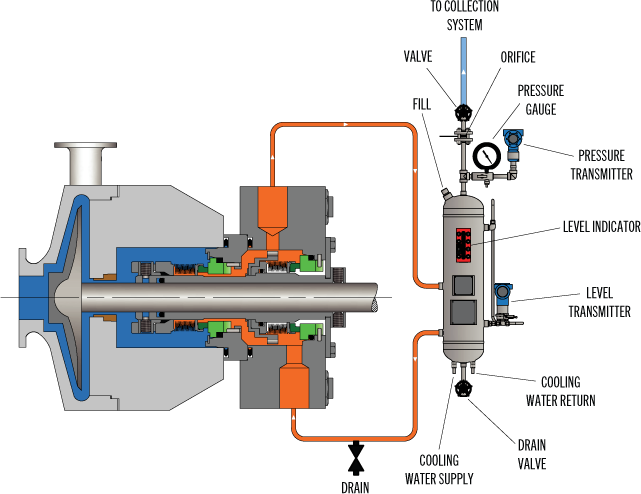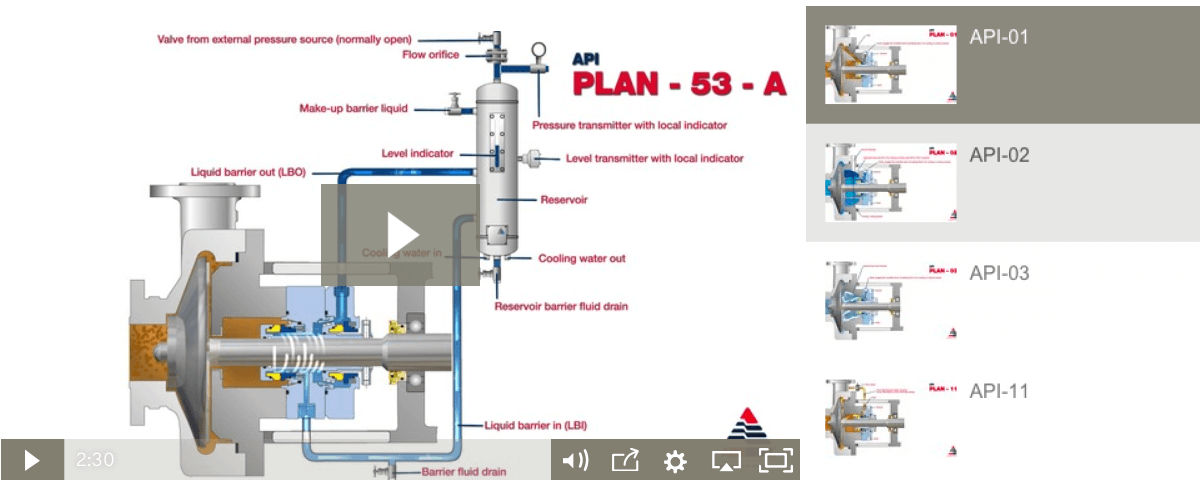api plan 52 mechanical seal free sample

Depressurised buffer fluid circulation in outboard seal of a dual seal configuration through a seal support system. Circulation is maintained by using pumping ring in running condition and by thermosyphon effect in stand still condition.
1. Keep the sealant vessel vent continuously open, which is necessary to maintain buffer fluid pressure close to atmospheric pressure and vent the vapors to flare.

The operating principle of this seal plan accepts a certain product leakage. So inevitably, the inboard seals will pass pump product – mind the seal faces – and may transform the buffer fluid into (hazardous) chemical waste.
Also, contrary to expectations, the low operating pressure of a plan 52 will not buy an inexpensive low-pressure design. It is common practice – and API 682 specified – to have the plan 52 seal support systems designed for the same pressure and temperature ratings as the pump. So the non-pressurized dual seal plan 52 solution will not save (much) compared to the pressurized plan 53 solutions. That is why for dual seal applications we would generally recommend the pressurized plan 53(B) solution as it has quite some advantages – explained elsewhere.
The non-pressurized plan 52 solutions should be considered though, for high purity applications where the pumped product accepts no contamination or when high sealing pressures would result in excessive heat loads.
Non-pressurized dual seal plan 52 solutions work best for clean, solids-free and non-polymerizing products with a vapour pressure that is higher than 1.1 bar-a at lowest ambient. It is better not used for products with a low(er) vapour pressure, nor products that are highly dangerous or lethal, like H2S gas.

API Plan 52 utilizes a reservoir and circulates an unpressurized buffer fluid between the inboard and outboard seals. To provide positive circulation through the support system and into the seal, a pumping ring is employed. Frictional losses in the buffer fluid inlet and outlet lines should be minimized by selecting the proper tube size, using large radius and/or 45 degree bends, and reducing the length of tubing runs. Plan 52 is commonly used with light hydrocarbons or fluids with a high vapor pressure. The buffer fluid must be compatible with process fluid as inboard seal leakage will eventually mix with the buffer fluid.
Plan 52 is available as a seal pot assembly. The associated field installation kit for use in connecting the seal pot assembly to your system is also available. Assembly components may include:
See page 31 of the Mechanical Seal Support Systems Application Guide for additional details and ordering information. Contact your authorized Swagelok sales and service center for information on optional components.

API Seal Plan 52 utilizes a reservoir and circulates an unpressurized buffer fluid between the inboard and outboard seals. To provide positive circulation through the support system and into the seal, a pumping ring is employed. Frictional losses in the buffer fluid inlet and outlet lines should be minimized by selecting the proper tube size, using large radius and/or 45 degree bends, and reducing the length of tubing runs. Seal Plan 52 is commonly used with light hydrocarbons or fluids with a high vapor pressure. The buffer fluid must be compatible with process fluid as inboard seal leakage will eventually mix with the buffer fluid.
Plan 52 is available as a seal pot assembly. The associated field installation kit for use in connecting the seal pot assembly to your system is also available. Assembly components may include:
See page 31 of the Mechanical Seal Support Systems Application Guide for additional details and ordering information. Contact your authorized Swagelok sales and service center for information on optional components.

From my understanding, API has recommendations on the frequency to refill 53s. However, it seems that changing your 52 fluid is ona case by case basis. At my refinery, they never change the oil in the 52s and run the pumps until failure. After failure, they clean the pots out and put in fresh fluid. The pots get pretty nasty after 2 years of service with no change of the fluid.
My question is, what are some general guidelines (other than look at the pot to see color of fluid) that you guys use to determine when to change the fluid? I have read some API documents that says get samples of the fluid from time to time to check the quality and assure no degradation, but i can guarantee they wont do that here.




 8613371530291
8613371530291